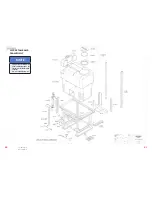
20
21
18/09/2016
LP-OMLINK-B
The pump will draw liquid from the tank and bypass
this until such time as you open the manual taps and
flick the main lever on the manual control unit to the
open position. Refer to the section below AR UCM
controller operation.
Once the boom taps and master on/off lever on
the manual control unit are in the open position,
the nozzles should spray. Using the rotary pressure
relief valve knob, you can now adjust the pressure
to the recommended spraying pressure by rotating
the PRV knob. Anti-clockwise rotation will reduce
the pressure; clockwise rotation will increase the
pressure. Using the pressure gauge on the control
unit, you can determine the spraying pressure. For
most boom-spraying jobs, a pressure between 1
and 5 bar (30 to 70 psi) is the norm. The AirMix™
low-drift nozzles can be safely operated within a
1-6 bar pressure range, but note that the Spray
Quality will be influenced by your spraying pressure.
For more information on Spray Quality, you can
access the Croplands Buyers Guide on line
and check the chart for AirMix™ nozzles – this
information is in the nozzle section.
Most chemical labels advise the application
rate and spray quality for the product being
used. Youmay wish to discuss this with your local
agronomist if you are unsure.
If you have electric controls or an Auto-Rate spray
controller fitted to you AgriPak linkage sprayer,
please refer to the Croplands manual relevant to the
model you have purchased to learn how to use this
prior to start up. Croplands Technical support can
also be contacted should you need assistance (see
back page for contact details)
Flushing tank – standard on 300, 600 and
800 litre models
A 3-way ball valve is provided on the suction line to
allow the operator to select suction from either the
main spray tank, or the fresh-water flushing tank.
CAUTION
Never use the fresh water flushing or
handwash tank for chemical use. These
tanks are designed specifically for
holding fresh water for either flushing the
sprayer, or in the case of the hand-wash
tank, for the operator to use for cleaning
hands or the suction filter in the field.
To flush the sprayer in the field after spraying, shut
off the boom using the liquid controls, stop the PTO
and leave the boom in the unfolded operating
position. Using the ball valve, select the fresh water
flush tank. Climb back into the tractor cab, start the
PTO and open the manual or electric control to
allow fresh water to flow through the spraying circuit
and the nozzles. If you have remaining spray left in
the main tank, flush only for one to two minutes to
flush the pump and boom lines.
If you have finished your spraying job and the
main tank is empty, you can flush the system for 5
minutes, or until the flushing tank is empty, to ensure
the system is thoroughly flushed with fresh water. It
is recommended to do this in the field so that any
chemical residue is deposited in the area you have
been spraying to avoid continual deposits back at
the spray shed site.
A thorough tank clean once back at the shed is
recommended if you have finished your spray
job. Always drain the main tank when finished. To
avoid algae build up in the fresh water tanks, it is
recommended these also be drained and refilled
just prior to the next spraying job.
This will ensure your AgriPak sprayer is ready to go
prior to its next use. To clean the filters:
»
Ensure the shut-off tap is in the “off” position, or
the shut off plug is removed from the filter housing
»
Remove the filter element from the housing by
undoing the main filter housing nut
»
Clean the filter element with fresh water (note,
if the suction filter does become blocked during
spraying, this can be cleaned in the field by using
the handwash tank
»
If a pressure filter is fitted (normally if the sprayer
has electric controls fitted), also remove the filter
cartridge and clean with fresh water
»
Inspect the nozzle filters, at least one from each
boom section, and if required, clean these in fresh
water. The nozzles filters are up inside the nozzle
body and can be accessed by removing the
nozzle cap. If care has been taken to have clean
water used for spraying, and the suction filter is
kept clean, the nozzle filters should not block.
After and extended time of non-use, it is
recommended you check the filters before your next
spray job. Often spiders or wasps can get into the
filter housing.
NOTE
Always use gloves when handling filters.
NOTE
Always clean the filters when your
spraying job is completed.












































